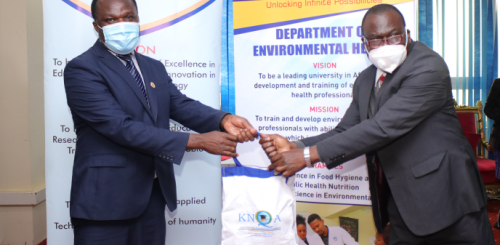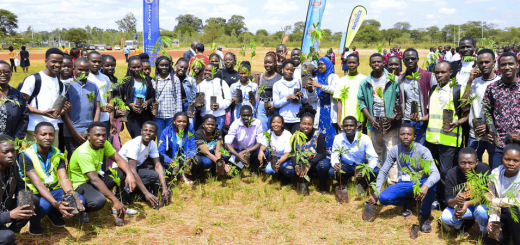Improve post-harvest practices for food security.
The agricultural sector is a key pillar of Kenya’s economy. According to the recent Food Security Report by Kenya Agricultural Research Institute, the sector directly contributes 24% of the Gross Domestic Product (GDP) and 27% of GDP indirectly through manufacturing and distribution. Around 45% of Government income comes from the agricultural sector and it contributes more than 75% of raw materials and over 50% of the export gains.
The sector is the leading employer contributing about 60 per cent of the total employment. Above 80% of the population, largely those living in rural areas, mostly obtain their livelihoods from agricultural related activities.
However, food security, which is among the big four agendas and Kenya’s sustainable development goal 2 has been a great concern for the longest period.
There has been many reasons why the country has not been able to achieve food security, mainly natural disasters; with drought and floods emerging as the most calamitous and others include climate change, pests like locusts and fall army worm, infectious diseases such as the recent COVID – 19, increased costs of food production for domestic use because of the very high cost of inputs especially seeds and fertilizer.
As much as these calamities are to blame for food insecurity today, food insecurity was still a major problem in Kenyan history.
According to the recent Food Security Report prepared by Kenya Agricultural Research Institute, 12 – 20 percent contribution to food insecurity is estimated to be post-harvest losses over the total national production. The main losses include spillages during handling, transportation due to poor transportation logistics, processing, aflatoxin contamination and rotting because of unfit handling technologies and insufficient storage facilities, mechanical vandalism during farm level fundamental processing and off-farm value addition.
Kenya imports everything for example onions, maize, eggs, beans yet the country has enough resources and the potential to produce enough food and protect the farmers from exploiters such as brokers and unscrupulous business people who bring about unfair competition and spoil the market price to the farmers. For instance, poultry farmers recently experienced influx of cheap eggs entering into country hence adversely affecting the market price of their products.
Lack of adequate infrastructure poses a big challenge to smooth logistics processes. In areas prone to natural disasters, there is need to establish enhanced logistics construction that will result in building capacity on logistics systems to ensure agile and effective supply chains and improving preparedness to emergencies hence reducing food loss and supporting rural livelihoods.
Embracing new technologies should be adopted to reduce these losses. Kenya can also attain food self-sufficiency by providing affordable tools and equipment to farmers by establishing efficient and transparent fertilizer and seeds subsidies, adequate transportation, adequate marketing of the products, capacity building of farmers and sharing with them necessary information, connect processing, storage and transportation, establishment of agricultural financing systems and improving storage and logistics facilities and increasing their capacity and not importing.
Above all, these post-harvest handling practices can be established and improved to reduce food loss in the country, namely, warehouse receipt system, cold storage, hermetically sealed bags and household silos sorting and grading, cleaning and modified atmosphere packaging, refrigerated vans, trailers, containers for transporting fresh produce like tomatoes, milk and the like to avoid unnecessary delays to get into the market.
This is because any delay between the harvest and the market of fresh produce can result in losses. Many of the losses are experienced by producers because of storage conditions and transportation delays. Transport and storage are of great significance to a modern food supply chain.
Transporting fresh products in refrigerated containers is not only convenient but also effective in preserving quality of food products. Importation of maize, rice, sugar and other food stuff will never solve the problem of food insecurity in this country but only serves to demotivate farmers affecting food production performance.
By doing this both large scale and small scale farmers will be motivated and encouraged to increase their production capacity and post-harvest losses will be reduced thereby increasing food production for consumption by farmers and rural as well as urban consumers.
This will also benefit consumers that are citizens from reducing losses, low prices, off farm value addition and improved food security. Post-harvest handling practices can also create employment.
Therefore, the issue of food security is the holy grail to combat hunger and create a livelihood for many people.
The Government should focus on supporting large scale and small scale farmers in the country to boost agricultural productivity and improve post-harvest handling practices that play an important role in improving quality of farm produce after harvest, provision of food materials all year round, control prices and establish proper policies and regulations, financial empowerment to farmers, open opportunities for export market other than importing and give agriculture a high priority as an important aid for promoting national development.
Consequently, the funds allocated to importation of maize and other food stuffs could be injected to improve post-harvest handling practices and in turn reduce the losses and bridge the gap between food production and consumption rate in the country and store enough for consumption during the occurrence of natural disasters and emergencies. The country could then export the surplus which would earn it revenue.

Author
Collins Musyoka (Supply Chain Practitioner)
School of Business and Economics
Mount Kenya University.













